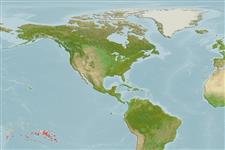Common names from other countries
Environment: milieu / climate zone / depth range / distribution range
экология
морской ассоциированный с рифами; немигрирующий; пределы глубины 40 - 100 m (Ref. 89972). Subtropical
Eastern Pacific: Cook Islands to Ducie Atoll (Pitcairn).
Size / Вес / Возраст
Maturity: Lm ? range ? - ? cm
Max length : 35.0 cm TL самец/пол неопределен; (Ref. 4858)
Inhabits rock and coral reef at depths of 30 to at least 60 m. Occurs in aggregations that swim high above the bottom; harems of 2-5 individuals. Feeds mainly on zooplankton, although some benthic material is probably consumed (Ref. 4858). Almost never exported through the aquarium trade (Ref. 48391).
Life cycle and mating behavior
половая зрелость | размножение | нерест | икра | Fecundity | личинки
Allen, G.R., 1985. Butterfly and angelfishes of the world. Vol. 2. 3rd edit. in English. Mergus Publishers, Melle, Germany. (Ref. 4858)
Статус Красного Списка МСОП (Ref. 130435)
CITES (Ref. 128078)
Not Evaluated
Угроза для людей
Harmless
Использование человеком
дополнительная информация
ссылкиаквакультура (рыбоводство)особенности рыбоводствастепень растяжениягенетикаElectrophoresesнаследуемостьболезниобработкаMass conversion
соавторыизображенияStamps, Coins Misc.звукиCiguateraскоростьтип плаванияжаберная областьOtolithsмозгзрение
инструменты
Специальные отчеты
Скачать в формате XML
ресурсы в Интернет
Estimates based on models
Preferred temperature (Ref.
115969): 25.1 - 28.4, mean 27.4 (based on 133 cells).
Phylogenetic diversity index (Ref.
82804): PD
50 = 0.5010 [Uniqueness, from 0.5 = low to 2.0 = high].
Bayesian length-weight: a=0.03090 (0.01359 - 0.07026), b=2.89 (2.70 - 3.08), in cm Total Length, based on LWR estimates for this (Sub)family-body shape (Ref.
93245).
Trophic level (Ref.
69278): 3.4 ±0.45 se; based on food items.
устойчивость к внешним воздействиям (Ref.
120179): низкий, минимальное время удвоения популяции 4.5-14 лет (Preliminary K or Fecundity.).
Fishing Vulnerability (Ref.
59153): Low vulnerability (25 of 100).
